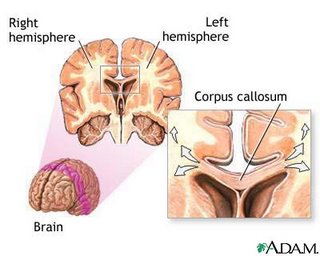
Firstly, there are two major structural differences between the neuroanatomy of males and females. The first of which is is the hypothalamus. Males and females differ in the preoptic area and the Suprachiasmatic Nucleus of it; the former controlling mating cycles and the latter controlling circadian rhythms and reproductive cycles. (Will not be elaborating on this in the post). When you referred to the brain stem linking the left and right hemispheres of the brain being thicker in females, I assume you are referring to the corpus callosum? That is the only bridge which connects both the left and right hemispheres of the brain. The corpus callosum is an independent structure, not a part of the brainstem (which only includes the medulla oblongata, pons, midbrain, thalamus and hypothalamus)
There have been conflicting studies on the differences between the gender dimorphism of the corpus callosum. However, researchers have agreed upon some of these differences. In the sagittal plane, the rostrum of the corpus callosum of the males is slightly larger than that of the females, while the rostral body, the isthmus and the splenium were somewhat larger in the females. In the coronal plane, the area of the male corpus callosum tended to be larger than that of the female.

However, the statistical differences in all males and females do not differ significantly to warrant a theoretical structual difference in the corpus callosum. Females however, do have a slightly thicker corpus callosum.
A thicker corpus callosum would mean that is more white matter (consisting of nerve fibres and axon projections). This would allow for a greater amount of coordination between activities that happen in both hemispheres of the brain. Because of the thinner corpus callosum, it is harder for both sides of the brain to work together in males and on the converse, it explains the ability for females to multitask.
If you do want more information, please do not hesitate to tell me. Or you could search for it using the keywords: Corpus Callosum, Dimorphism.
Useful references:
Dubb A, Gur R, Avants B, Gee J. "Characterization of sexual dimorphism in the human corpus callosum."
1 comment:
Interesting. Thank you.
I have to do a talk about the brain in a school (not quite this subject but a related one) for school kids. Will it be OK with you if I use your image posted on here (the one that says ADAM at the bottom) to illustrate something in the talk please?
Many thanks
Harriet
Post a Comment